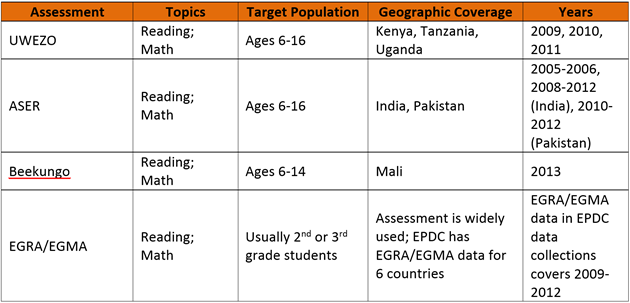You are here
About EPDC Learning Outcomes Data
Learning Outcomes Data
There is a growing body of learning assessments used to ascertain the extent to which students are gaining the fundamental skills needed to succeed in the middle and upper grades of basic and secondary education. As a body, these assessments can be used to gain a sense of the academic skills of early and middle grade students in more than 100 countries.
The EPDC collection of learning outcomes data focuses on presenting reading, math, and science performance from these international, regional, and national assessments. The EPDC collection does not currently include pass rates for national school entrance or school completion examinations since pass rates may often be based on quotas or numbers of seats available rather than learning achievement.
International and regional learning assessments used by EPDC to construct measures of basic learning
.png)
National assessments used by EPDC to construct measures of basic learning

The EPDC database presents learning outcomes information from these assessments, where possible, as average performance scores and the percentage of test-takers at test-specific performance or learning levels. The latter set of indicators defines whether youth meet, exceed, or fall below learning benchmarks set by each assessment. Assessment data can provide a sense, for example, of the percentage of students who are reading at the lowest performance benchmark or who have reached the highest performance benchmark. These benchmarks are different for each assessment because each assessment uses different constructs, tools, and procedures. Additionally, assessments vary in the standards for each learning achievement benchmark, the number of benchmarks according to which test-takers can be evaluated, and the youth populations they test. Because of these differences, EPDC’s benchmark indicators should not be compared across assessments.
Rather than attempt to catalogue the range and diversity of benchmarks used by different assessments in the EPDC database, we use learning outcomes benchmarks to organize students into three broad categories that should be understood in relation to the standards and benchmarks specific to each assessment:
1) Percentage of pupils performing below the lowest learning benchmark
2) Percentage of pupils performing at or above the lowest learning benchmark
3) Percentage of pupils performing at the highest learning benchmark
These categories of learning achievement are intentionally vague so that they can accommodate the different standards used by different assessments. Database users are encouraged to interpret these indicators in conjunction with the background information on assessments and performance levels available on the EPDC webpage dedicated to each assessment or group of assessments. Links to these webpages are available below, and the tables on those pages document the learning benchmarks defined by each learning assessment as well as how EPDC designates these learning benchmarks as indicating ‘below the lowest learning benchmark,’ ‘at or above the lowest learning benchmark,’ or ‘at the highest learning benchmark.’ EPDC’s approach borrows from The World Bank’s EdStats portal, which reports certain learning outcomes data according to the lowest and highest proficiency levels on scales used by different assessments (datatopics.worldbank.org/Education/wDataQuery/QLearning.aspx).
Users should note that the three categories of learning achievement used by EPDC are not mutually exclusive. The percentages of students who perform at or above the lowest learning benchmarks, and who perform at the highest learning benchmark overlap since both categories include students who are at the highest learning benchmark.
EPDC also makes more detailed supplementary datasets available as Excel spreadsheets that can be downloaded under the Research documents section of the EPDC website. These datasets complement the data included in the EPDC database. They detail the percentage of test-takers performing at a fuller set of levels on an assessment scale, and indicators in these datasets use the performance levels identified by an assessment rather than the more general EPDC benchmarks used in the main EPDC database. These datasets offer a rich, assessment-specific view of learning levels associated with a certain assessment or family of assessments. Indicators in these datasets are calculated as stand-alone indicators, so the percentage of youth performing at a certain level includes both children for whom that level was the highest performance level reached and children who performed at higher levels on an assessment scale. EPDC also provides information from EGRA assessments as supplementary datasets. As with the learning outcomes indicators in the EPDC database, users should refer to the information in the About EPDC Data section of the EPDC website for details about each assessment when using the supplementary datasets.
About TIMSS and PIRLS
About SACMEQ and PASEC
About LLECE
About ASER, UWEZO and Beekungo
About EGRA and EGMA
